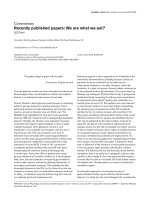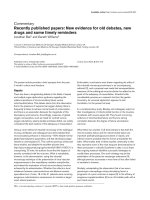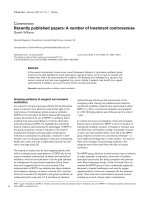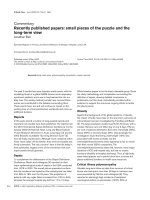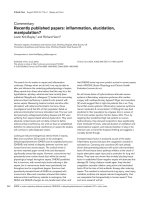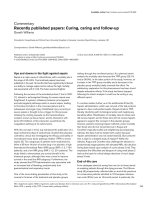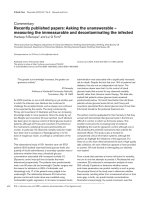Báo cáo y học: " Recently published papers: We are what we eat" pot
Bạn đang xem bản rút gọn của tài liệu. Xem và tải ngay bản đầy đủ của tài liệu tại đây (33.3 KB, 3 trang )
APACHE = Acute Physiology and Chronic Health Evaluation; ICU = intensive care unit; MI = myocardial infarction; SMART = Systemic Mediator
Associated Response Test.
Available online />The glutton digs his grave with his teeth
Anonymous English proverb
Over the past few months yet more information bombards us.
Several papers have concentrated on nutrition and markers
thereof, in an attempt to make sense of much data.
Current interest in blood glucose levels focuses on examining
patients’ glucose tolerance to predict outcomes. This is
particularly pertinent to high-dependency and coronary care
practice, as well as intensive care unit (ICU) work. The
DIGAMI study highlighted the long-term post-myocardial
infarction (MI) risk in patients with a deranged glycometabolic
state [1]. Similarly, the intensive care population has been
scrutinized with regard to glycometabolic control in septic
critically ill patients. Strict glycaemic control in such
individuals is now hopefully commonplace, with the aim of
improving survival. This has prompted much work to
delineate those individuals with impaired glycometabolic
control, and the same group presented further evidence that
abnormal glucose metabolism is associated with a high
prevalence of acute MI [2]. A total of 181 consecutive
nondiabetic patients admitted with acute MI were given
standard glucose tolerance testing at discharge and
3 months later. Fewer than 35% of patients had normal
glucose tolerance at 3 months of follow up. It would appear
likely, then, that early detection of impaired glycometabolic
control might improve outcome by allowing introduction of
secondary preventative measures. This probably has little
immediate relevance to the ICU, but for those of us who are
involved in coronary care it is worthwhile bearing in mind that
an HbA
1c
on admission may well indicate long-term risk and
is a relatively quick and inexpensive test.
Nutritional support is often regarded as the Cinderella of the
intensivist’s armamentarium, probably because it does not
generate the same excitement as the latest test for
inflammatory mediators or suchlike. However, rather like
toothache, it is best not ignored. Intense debate continues as
to the preferred route of administration. The recent report by
Montejo and colleagues [3] does little to help. A prospective
randomized study comparing the efficacy and complications
of early jejunal versus gastric feeding was undertaken in a
sample group of some 101 ICU patients who were deemed
to need enteral nutrition for more than 5 days. Interestingly,
the sample group comprised fewer than 6% of patients
admitted to the 14 centres involved, with more than 12%
being given mandatory total parenteral nutrition. Little overall
difference between the two groups was identified, which in
part may be explained by the small numbers involved. As
expected, the jejunal route resulted in significantly lower
residual volume, but this did not translate into higher volumes
of diet or indeed increased caloric intake, principally because
of increased frequency of tube-related complications (i.e.
occlusion, withdrawal [accidental] and displacement). For
those of us who have struggled with nasogastrojejunal tubes,
some solace is found within this paper. Furthermore, there
was no difference in the incidence of nosocomial pneumonia
in the two groups, again possibly reflecting the numbers
studied. The authors point out that the study shows that the
transpyloric tube is as useful as a nasogastric tube for early
nutrition in the critically ill. One may argue that this implies a
lot more effort for little or no benefit. No doubt further studies
will address this. The alternative is of course to befriend an
amenable surgeon.
An alternative approach to accelerate recovery of
gastrointestinal motility may be effective salt and water
balance. In a study by Lobo and colleagues [4], prompted by
Commentary
Recently published papers: We are what we eat?
LG Forni
Consultant, Worthing General Hospital, Lyndhurst Road, Worthing, West Sussex, UK
Correspondence: Lui G Forni,
Published online: 9 July 2002 Critical Care 2002, 6:295-297
This article is online at />© 2002 BioMed Central Ltd (Print ISSN 1364-8535; Online ISSN 1466-609X)
Critical Care August 2002 Vol 6 No 4 Forni
animal models, 20 patients were randomized to standard
postoperative intravenous fluids (at least 1 litre 0.9% NaCl
plus 2 litres 5% dextrose per day) or restricted sodium and
water intake (2 litres of water plus 77 mmol sodium per day).
Those in the restricted group showed significantly improved
solid-phase and liquid-phase gastric emptying times on
postoperative day 4, as well as a reduction in loosely defined
complications and in hospital stay. Although intriguing, that
study is open to several criticisms. Those in the restricted
group were managed remotely from those offered standard
treatment, and fluid input was managed solely by one of the
investigators. The standard treatment implied little thought as
to volume balance, which I am sure was not the case. Also,
the elegant studies on gastric emptying were incomplete in
the standard group. It may well be that other units approach
the problem of postoperative ileus in a different manner,
utilizing epidural analgesia, laparoscopic surgery and early
mobilization to improve results. The authors also suggested
that moderate restriction of salt and water may benefit some
critically ill patients. Although this may be the case in a few
instances, there is considerable evidence that early
aggressive volume resuscitation in septic patients can have
dramatic effects on mortality. As such I would take their last
comments with a pinch of brine! For those interested, a
balanced view to this work is provided by Heyland and
Paterson [5].
An interesting alternative with respect to volume resuscitation
was recently described. Horstick and colleagues [6]
subjected rats to volume-controlled haemorrhagic shock and
examined the mesenteric microcirculation as well as other
parameters following resuscitation with similar volumes of
either 20% albumin infusion or 0.9% NaCl. A significant
improvement in global haemodynamics was found, together
with an improvement in the microcirculation, when albumin
was used as the resuscitation fluid. Clearly, the albumin story
continues to run but, as Horstick and colleagues pointed out,
this experimental scenario is vastly different from that which is
often encountered clinically, and not surprisingly they suggest
a need for further experimentation and clinical studies.
Albumin is also the subject of a recent study reported by Yap
and coworkers [7]. They retrospectively studied more than
1000 patients over an 18-month period, their hypothesis
being that serum hypoalbuminaemia may be predictive of
mortality risk in the critically ill. This was no doubt triggered
by the Acute Physiology and Chronic Health Evaluation
(APACHE) III as well as the study reported by McCluskey
and colleagues [8]. Unlike the latter study, Yap and
coworkers failed to show that serial measurement of albumin
was as accurate as APACHE II in predicting outcome,
although they agreed that serum albumin is associated with
acute physiological illness and mortality. They pointed out
that their data suggest that serum albumin is a poor predictor
of hospital mortality, and the referees should be
congratulated on publishing relatively negative results.
Another surrogate of nutritional and overall health status is
haemoglobin concentration. An observational study
conducted in over 2000 patients who underwent coronary
artery bypass surgery [9] examined in-hospital mortality with
respect to haemoglobin concentration. The crude mortality
rate was five times higher among patients with a
haemoglobin of 100 g/l or less. The authors concluded that
comorbidity probably had the greatest effect on outcome, as
indicated by the reduced haemoglobin levels. There was no
evidence to support perioperative correction of anaemia. No
doubt studies will soon be focused on the use of
erythropoietin preoperatively.
Acute sepsis and markers thereof continue to provide much
excitement, although the prognostic value of certain markers
such as procalcitonin remain in doubt. Claeys and colleagues
[10] studied procalcitonin in septic patients and tried to
determine its relationship with more conventional markers,
including C-reactive protein and white cell count. Individuals
with septic shock (n = 53), as defined by the American
College of Chest Physicians Consensus, were studied. All
patients had elevated procalcitonin and C-reactive protein
levels within 24 hours of diagnosis. However, baseline values
were of no predictive value. Indeed, single measures of
procalcitonin did not discriminate between survivors and
nonsurvivors when examined within the first 5 days of
admission. There was some evidence that time-dependant
changes in procalcitonin may provide an earlier indicator of
survival, but equally other nonquoted variables such as
inotrope usage, fractional inspired oxygen, or indeed blood
pressure may be just as good pragmatically.
Continuing the procalcitonin story, yet another article on
proinflammatory cytokine clearance using continuous
venovenous haemofiltration was reported [11]. Curiously, this
paper infers that procalcitonin is an important clinical
prognostic marker in septic patients, which is rather at odds
with the findings described above. Using an AN69
membrane, concentrations of the inflammatory mediators
measured were significantly reduced, but in keeping with
other studies this effect was decreased after 12 hours,
probably reflecting progressive membrane saturation. One
point that this paper does highlight is that clearance of such
mediators is entirely membrane dependent. What
implications do those findings have for the use of continuous
venovenous haemofiltration in sepsis? My personal view is
that the jury is still out. If one views the circulation as the
dumping ground for cytokines, one wonders whether such
removal has any effect at the cellular level.
Finally, what predictions can be made in critically ill patients?
In intensive care we are blessed with a variety of scoring
systems of varying complexity, most of which predict mortality
with similar efficacy. To date, scoring systems have not been
particularly good at predicting the events that determine ICU
mortality, such as the development of organ failure. Slotman
[12] described a multivariate predictive model imaginatively
described as the SMART (Systemic Mediator Associated
Response Test) system. In an impressively thrifty manner, he
used the data obtained from the placebo arm of a phase III
clinical trial. An impressive array of data had been collected,
including interleukin-6, interleukin-8 and granulocyte colony-
stimulating factor levels, which were used randomly to
develop a training cohort (200), the further 103 data sets
being used to provide prospective validation. Through using
the training cohort, multivariate models were developed to
predict acute respiratory distress syndrome, renal
insufficiency, hepatobiliary dysfunction and disseminated
intravascular coagulation, as defined according to
established criteria. The aim of such a SMART model could
be to predict the development of organ dysfunction, and in
the future it may enable tailored therapies to be introduced
early. The author points out valid criticisms of the model and
highlights some of its limitations. However, he should be
commended. With the growth of fully automated clinical
information systems, it may not be too long before SMART-
like models, allied with clinical judgement (hopefully!),
become commonplace in ICUs. ‘He that would know what
shall be, must consider what hath been’ (quotation: Fuller T
[1654–1734]). Slotman has taken that advice, and we wait
to see what the future brings.
Competing interests
None declared.
References
1. Malmberg K, Norhammer A, Wedel H, Ryden L: Glycometabolic
state at admission: important risk marker of mortality in con-
ventially treated patients with diabetes mellitus and acute
myocardial infarction: long-term results from the diabetes and
insulin-glucose infusion in acute myocardial infarction
(DIGAMI) study. Circulation 1999, 99:2626-2632.
2. Norhammar A, Tenerz A, Nilsson G, Hamsten A, Efendic S, Ryden
L, Malmberg K: Glucose metabolism in patients with acute
myocardial infarction and no previous diagnosis of diabetes
mellitus: a pospective study. Lancet 2002, 359:2140-2144.
3. Montejo JC, Grau T, Acosta J, Ruiz-Santana S, Planas M, Garcia-
De-Lorenzo A, Mesejo A, Cervera M, Sanchez-Alvarez C, Nunez-
Ruiz R, Lopez-Martinez J; Nutritional and Metabolic Working
Group of the Spanish Society of Intensive Care Medicine and
Coronary Units: Multicenter, prospective, randomized, single-
blind study comparing the efficacy and gastrointestinal com-
plications of early jejunal feeding with early gastric feeding in
critically ill patients. Crit Care Med 2002, 30:796-800.
4. Lobo DN, Bostock KA, Neal KR, Perkins AC, Rowlands BJ, Allison
SP: Effect of salt and water balance on recovery of gastroin-
testinal function after elective colonic resection: a randomised
controlled trial. Lancet 2002, 359:1812-1818.
5. Heyland DK, Paterson WG: Fluid restriction for postoperative
patients? [Comment]. Lancet 2002, 359:1792-1793.
6. Horstick G, Lauterbach M, Kempf T, Bhakdi S, Heimann A, Hor-
stick M, Meyer J, Kempski O: Early albumin infusion improves
global and local haemodynamics and reduces inflammatory
response in hemorrhagic shock. Crit Care Med 2002, 30:851-
855.
7. Yap FHY, Joyn GM, Buckley TA, Wong ELY: Association of
serum albumin concentration and mortality in critically ill
patients. Anaesth Intensive Care 2002, 30:202-207.
8. McCluskey A, Thomas AN, Bowles BJM, Kishen R: The prognos-
tic value of serial measurements of serum albumin concen-
tration in patients admitted to an intensive care unit.
Anaesthesia 1996, 51:724-727.
9. Zindrou D, Taylor KM, Peder Bagger J: Preoperative haemoglo-
bin concentration and mortality rate after coronary artery
bypass surgery. Lancet 2002, 359:1747-1748.
10. Claeys R, Vinken S, Spapen H, ver Elst K, Decochez K, Huyghens
L, Gorus FK: Plasma procalcitonin and C-reactive protein in
acute septic shock: clinical and biological correlates. Crit Care
Med 2002, 30:757-762.
11. Dahaba AA, Elawady GA, Rehak PH, List WF: Procalcitonin and
proinflammatory cytokine clearance during continuous ven-
ovenous haemofiltration in septic patients. Anaesth Intensive
Care 2002, 30:269-274.
12. Slotman GJ: Prospectively validated prediction of physiologic
variables and organ failure in septic patients: The Systemic
Mediator Associated Response Test (SMART). Crit Care Med
2002, 30:1035-1045.
Available online />

